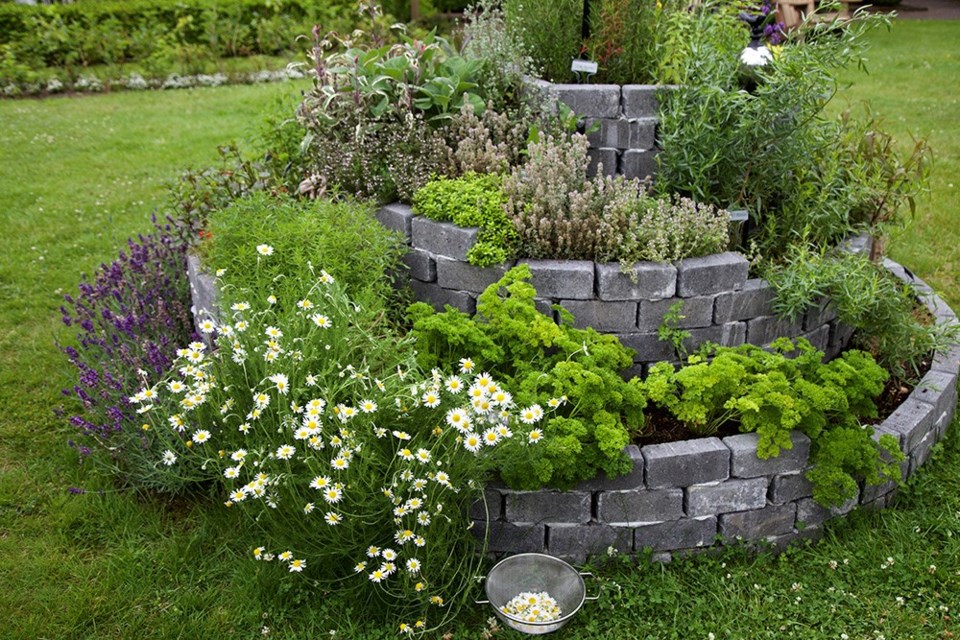As an urban permaculture designer, my goal is to introduce as many fun, delicious and “productive” ideas as I can, encourage non-gardeners to grow food, and to get experienced gardeners to try something new.
Herb spirals are one such idea – popular in permaculture circles, but little known in mainstream garden design. I think of my herb spiral as a one-stop culinary trip around the world. Its many microclimates allow me to grow native and exotic herbs fundamental to many ethnic cuisines, and all within a very small footprint. In a space crunch, dwarf tomatoes, and succession plantings of lettuces, radishes, beets and other vegetables can be integrated successfully.
My spiral is about two metres wide and one metre tall. If the circles were one dimensional, the plantable area would be about 3.6 square metres, but because the 30- to 45-centimetre-wide bed is linear, running at an incline over 10 metres in a spiral pattern to the top, there is a considerable gain not just in altitude and real estate, but in opportunity.
From a bird’s eye view, a herb spiral looks very much like a snail or nautilus shell - shapes that are based on nature’s sacred geometry. Sacred geometry reflects the universe, its pure forms and the relationship between nature and man, the parts and the whole. While spirals in nature tend to follow the “Golden Ratio” (Phi) or the “Fibonacci Sequence” in their rates of expansion, my herb spiral claims no such accuracy. Like all permaculture installations and systems, we mimic nature’s logic but we cannot match her accuracy or precision.
I do very little to maintain the plants in my spiral, yet they are so prolific that many harvests are required over the season. I cook daily with fresh herbs, and hang great bundles of them in the kitchen to dry, for use in culinary and medicinal applications, and for gifting.
The premise behind a herb spiral is to create diverse growing environments for culinary and medicinal herbs at various elevations, utilizing various soil and drainage conditions, and various directional exposures to sun, shade, wind, frost, etc., and to utilize gentle slopes and soil bulk to slow down the natural movement of water, leaving just enough of it where it is needed to maintain ideal growing conditions.
With just a little planning and patience, you can grow and harvest everything from angelica to watercress, and maintain a small bog or pond at ground level, on the deep shade side of the installation. I opted for a boggy pseudo-creekbed-like area for watercress because, where we live, a pond would attract raptors, racoons and coyotes.
Traditional permaculture herb spirals utilize stones and small logs, broken cement, glass bottles, and other found materials. In planning my front yard spiral, I had to consider neighborhood culture, decades old community design considerations, and also my neighbours’ views and happiness. I built the spiral using traditional principles and scale, but with materials that were more sympathetic to the established esthetic of the community. Tumbled grey bricks, diverted from another building site complemented the 72-year-old bones of our home. Assorted bricks and rocks fortified the hidden centre column of the structure, at no cost.
Ideally, herb spirals live handily, no more than three metres from one’s kitchen door. To that end, and to demonstrate the principle to balcony and patio gardeners, I created a highly modified, compact herb spiral using two galvanized livestock tanks fitted with castors and filled with all manner of herbs, small vegetables, and berries. The elevation, sun, heat, light, shade exposures are similar, but there are no spirals, rather one squat 321-litre horse watering tank, with one tall 75-litre feed bin set into it. Both bottoms, and the inset bin sides, were drilled for drainage. It works beautifully and looks gorgeous on my patio.
I created a similar mini spiral recently for a friend who loves to cook but is brand new to gardening. The spiral is his favourite new ingredient.
Garden centres are chock-full of gorgeous perennial herb seedlings. Why not try building your own herb spiral?
Laura Marie Neubert is a West Vancouver-based urban permaculture designer. Follow her on Instagram @upfrontandbeautiful, learn more about permaculture by visiting her Upfront & Beautiful website or email your questions to her here.
For a taste of permaculture, click on the YouTube link below:
(Video - Courtesy of West Vancouver Memorial Library)

